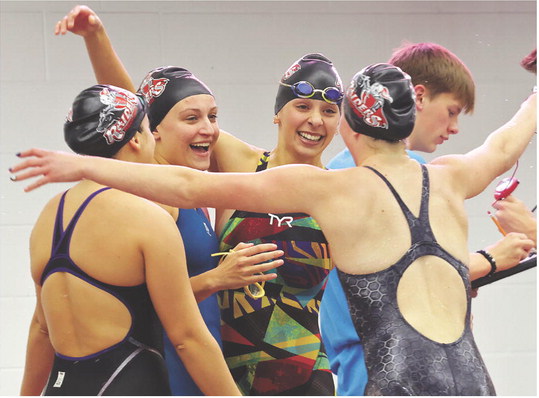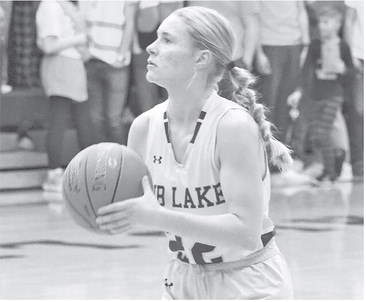NFHS offers a glimpse of what a return to play may look like
The return of high school sports isn’t going to happen with the flip of a switch in the aftermath of the COVID-19 pandemic.
A glimpse into what it could look like was revealed last week when the National Federation of State High School Associations (NFHS) released guidelines on the resumption of high school athletic opportunities. The NFHS serves as the national governing body for high school sports.
The document was developed by the NFHS Sports Medicine Advisory Committee (SMAC), a 15-member advisory committee comprised of medical doctors, certified athletic trainers, high school coaches and officials, research specialists and state high school association executives that regularly develops position statements related to medical aspects of conducting high school athletics.
T he document does not issue any rules. It just offers guidelines for state associations to consider as they work with state and local health departments to get sports back up and running.
The Wisconsin Interscholastic Athletic Association (WIAA) has not yet released plans or timelines for re-starting other than leaving open a potential window for 30 contact days this summer for spring sports teams that had their seasons canceled in April.
However, in a nearby item to watch, the Iowa High School Athletic Association and Iowa Girls High School Athletic Union are opening their summer baseball and softball seasons June 1 with the blessing of Gov. Kim Reynolds. Iowa is the only state that typically holds its baseball and softball high school seasons in the summer. Under Iowa’s plan, practices will be allowed to begin June 1 with several social distancing and personal hygiene guidelines in place. Games can start June 15 leading up to the postseason tournaments, which start in mid-July. Practices for those sports normally start in early May.
“The NFHS SMAC believes it is essential to the physical and mental well-being of high school students across the nation to return to physical activity and athletic competition,” the guidance document states. “The NFHAS SMAC recognizes that it is likely that ALL students will not be able to return to –– and sustain –– athletic activity at the same time in all schools, regions and states. There will also likely be variation in what sports and activities are allowed to be played and held. While we would typically have reservations regarding such inequities, the NFHS SMAC endorses the idea of returning students to school-based athletics and activities in any and all situations where it can be done safely.”
At lower levels, organizations like the Medford Youth Soccer Association and Rib Lake PRIDE have canceled their 2020 summer seasons, while the Medford Area Little League Association’s Board of Directors was scheduled to meet Wednesday night to discuss its remaining options.
Phases, risk groups
The most noteworthy items the NFHS SMAC suggests in the guidance document is a phased approach to returning to competition and separating sports into varying degrees of risk. Phases for “opening up” are based upon White House guidelines released in April.
The committee included football and wrestling as “higher risk” sports, while individual running and throwing events, individual swimming, golf and cross country (with staggered starts) were listed as “lower risk” sports. In between, basketball, volleyball, baseball, softball, soccer, gymnastics, hockey, tennis and track meet field events were listed as moderate risk, though most of those could potentially be considered “lower risk” with appropriate cleaning of equipment and use of masks by participants.
The basis for placing sports in a risk category is the potential for exposure to respiratory droplets, which “is the guiding principle behind social distancing and the use of face coverings.”
The suggestions for Phase 1 of a restart include pre-workout screenings for all coaches and students for signs/ symptoms of COVID-19, including a temperature check, no gatherings of more than 10 people at a time, no shared water bottles or hydration stations, no use of locker rooms and a minimum distance of 6 feet between each individual at all times. Workouts would be conducted in “pods” of students with the same 5-10 students always working out together. There would be no shared athletic equipment (towels, clothing, shoes, balls, etc.). All athletic equipment, including balls, would be cleaned between uses. Frequent cleaning of athletic facilities and opportunities for participants to wash or sanitize hands are recommended and students would be encouraged to shower and wash their workout clothing immediately upon returning home.
With a move to Phase 2, the guidelines include continued screening of all coaches and students, continued frequent cleaning of facilities, hand washing/ sanitizing and an increase to 50 individuals gathering at an outdoor workout. Ten would still be the limit indoors. Locker and meeting rooms may be opened but individuals remain 6 feet apart. Workout pods remain at five to 10 of the same students.
Lower risk sports practices and competitions could resume, modified practices could begin for moderate risk sports. All equipment would need to be cleaned intermittently during practices and contests and should continue to be cleaned between each use. Towels and clothing still would need to be cleaned after each use.
The screening guideline for Phase 3 calls for any person who has had a fever or cold symptom in the last 24 hours to be held out of the practice or contest and contact his or her primary care provider or appropriate health care professional. Vulnerable individuals could resume public interactions but should practice social distancing.
Gatherings of up to 50 individuals would be allowed indoors or outdoors. When not directly participating, individuals should remain 3 to 6 feet apart. Moderate risk sports practices and competitions could begin, while modified practices could begin for higher risk sports with pre-practice screening called for in Phases 1 and 2, showers immediately after workouts. It’s recommended in the document that states “re-assess epidemiology data and experiences in other states and other levels of competition to determine when higher risk sports competition may resume.”
More to consider
The committee offered several more items for state associations to consider in their re-start plans in last week’s guidance document.
Among those key points are:
_ The questions of whether state associations will conduct a regular season or championship if public schools statewide or in COVID-19 “hotspots” are closed.
_ Will state associations conduct a regular season or championship for lower risk sports yet cancel higher risk sports?
_ State, local or school district guidelines for cloth face coverings should be strictly followed. Cloth face coverings are acceptable and encouraged, especially in Phases 1 and 2, except for swimming, distance running or other high intensity aerobic activity.
_ State associations should be prepared for periodic school closures due to recurrent outbreaks.
_ Schools should consider less travel when possible in scheduling contests.
_ Who should be allowed at events? The guidelines recommend grouping people into three tiers. Tier 1 (essential) would include athletes, coaches, officials, event staff, medical staff, security. Tier 2 (preferred) is the media. Tier 3 (nonessential) are spectators and vendors. The recommendation is for only Tier 1 and Tier 2 to be allowed to attend events until state/local health departments lift restrictions on mass gatherings.
_ The NFHS and other organizations are in the process of drafting for pre-season conditioning and acclimatization guidelines for fall sports. While current models assume athletes have deconditioned over the summer, the pandemic may result in students being conditioned for four to five months or more.




